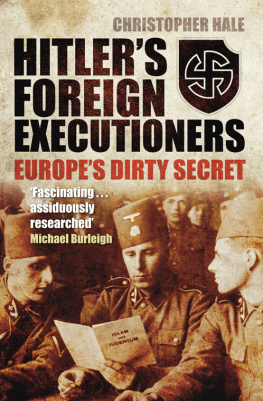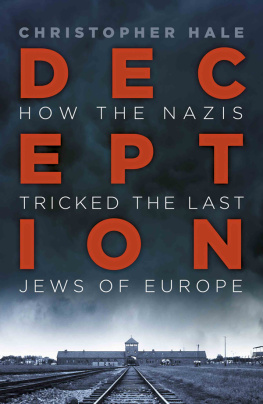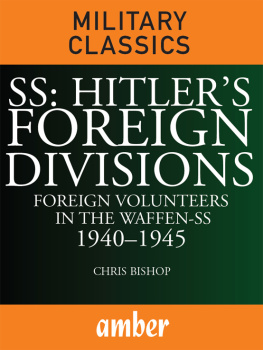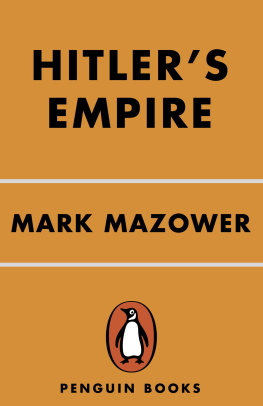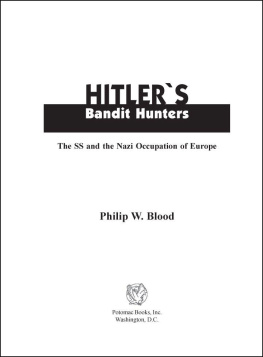One basic principle must be the basic rule for the SS man: we must be honest, decent, loyal, and comradely to members of our own blood and to nobody else In twenty to thirty years we must really be able to provide the whole of Europe with its ruling class.
Heinrich Himmler, 4 October 1943
The Romanians act against the Jews without any idea of a plan. No one would object to the numerous executions if the technical aspect of their preparation, as well as the manner in which they are carried out, were not wanting The Einsatzkommando has urged the Romanian police to proceed with more order.
Report by Einsatzgruppe D, 31 July 1941
A Jew in a greasy caftan walks up to beg some bread, a couple of comrades get a hold of him and drag him behind a building and a moment later he comes to an end. There isnt any room for Jews in the new Europe, theyve brought too much misery to the European people.
Danish SS volunteer
The very broad scope of this book was challenging. I must thank first of all Simon Young who took time out from his busy schedule to provide invaluable advice and hands on assistance with a recalcitrant manuscript. Professor Michael Burleigh, William Niven and Nigel Jones read parts of the manuscript. Judith Lanio assisted with a mass of German language documents and texts with great efficiency. Christian Barse assisted with Danish materials. A number of historians generously responded to my many questions: Marko Attilla Hoare, Milan Hauner, Clemens Heni, David Cesarani, Andrew Ezergailis, Martin Dean, Wendy Lower, Martin Conway, Saul David, Adam Sisman, Timothy Snyder and Giles MacDonough all provided expert advice. Matthew Kott offered valuable insights into the German occupation of Norway, Latvia and the Baltic. At a critical stage, Ephraim Zuroff and Dovid Katz made valuable contributions. Detlef Siebert provided vital leads. I am grateful to Julian Hendy and Ray Brandon for generously sharing their insights and hard-won information about Ukrainian nationalism and the formation of the SS Division Galizien. George Lepre and Michael Melnyk, who have written accounts of the Bosnian Handschar and the Ukrainian Galizien SS divisions respectively, sent unique documentary materials. From these, I have drawn my own and no doubt different conclusions.
I spent many hours in some excellent libraries, above all the British Library and the Weiner Library in London. The National Archives in Kew was another important resource. I must also thank three German libraries: the German National Library in Leipzig, the State Library and the excellent Library of the Topography of Terror in Berlin. I am especially indebted to the Bundesarchiv/Zentralle Stelle in Ludwigsburg. I discussed the problems of collaboration with Ojrs riks Kalnin at the Latvian Institute and with historians at the Museum of the Occupation, Riga, the Riga Ghetto and Latvian Holocaust Museum and the Central State Archives in Kiev. Needless to say, I alone am responsible for any errors of fact and judgement.
I welcome corrections, comments and further research proposals through the website listed at the end of the Acknowledgements.
I thank Pimlico Books for permission to quote from Mihail Sebastians Journal: 19351944 (2003) and the United States Holocaust Memorial Museum for permission to use extracts from Frida Michelsons remarkable memoir I Survived Rumbuli (1979).
Richard Johnson, Patrick Janson-Smith and Neil Blair backed the project at the beginning of a long haul. Simon Hamlet, Christine McMorris and Lindsey Smith at The History Press bravely took on a long manuscript. I must also thank some good friends: Laurence Peters, who read parts of the book and made valuable suggestions; Gerda Sousa; Karin Kaschner-Sousa; and David Robson, Sarah Dewis (and family), who provided varieties of nourishment and accommodation. My wife Diana Bhmer and our son Jacob put up with my periodic disappearances with fortitude: my love to them.
www.hitlersforeignexecutioners.com
Contents
I have taken a pragmatic approach to German terms. Most specialised organisational terms are given in German to begin with and thereafter in English (Special Task Force for Einsatzgruppe, for example, although there is no Special in the term), unless the original has become broadly accepted Der Fhrer for example. I have referred to SS ranks in German to distinguish them from army ranks.Die Wehrmacht in English language books has come to signify the German ground forces strictly speaking Das Heer. After 1935, the term embraced all the armed forces in the Third Reich, including the army, navy and air force. For this reason I refer to the German army rather than the Wehrmacht. I have treated place names on a case-by-case basis.
Riga, 2010
Imagine Whitehall on a dank, autumn morning. A far-right British political party leader steps towards the Cenotaph, jaw set, dark suited, clutching a wreath. Behind him stands the party elite sporting banners displaying back and white photographs of hard-faced men in grey military uniforms. A dense police cordon holds back jeering anti-fascists who have gathered in Parliament Square. He and his followers have come here to commemorate a handful of forgotten anti-communist martyrs who joined the German armed forces and fought against Stalin during the Second World War. After solemnly placing the wreath at the foot of Edwin Lutyens chaste memorial to the dead of the Great War, the party leader makes a short, angry speech denouncing the post-war British government for punishing these brave, far-sighted warriors as traitors. History has proved them right! As he finishes, an egg splatters on his immaculate black coat. Then the party men march up Whitehall to Trafalgar Square, closely pursued by protestors. Scuffles erupt, banners are trampled underfoot. Tourists and passers-by scratch their heads, puzzled. Who on earth were these heroic anti-communists?
In August 1942, an odious public school dropout called John Amery and his companion Jeannine Barde arrived in Berlin masquerading as Mr. and Mrs. Browne. Amery was very well connected: his father was Secretary of State for India and his brother, Julian, an illustrious war hero. German world view, John Amery was no great catch. His grandmother had been a Hungarian Jew who had found refuge in Britain, but the Amery clan were all diehard conservatives. Given this bigoted cradling, it is not surprising that John became a fervent anti-communist whose views, at least to begin with, mimicked those of his father and brother. But unlike them, he became an outspoken and virulent anti-Semite who was in thrall to the vicious Jew hatred of French ultranationalist culture. John Amery spurned his well-to-do family and became a dedicated bohemian. He contracted syphilis at the age of 14 and by the time he arrived in Berlin was an alcoholic bigamist, burdened by massive debts. But Hitler and the German Foreign Office had a crass understanding of English social mores and it took them a long time to understand that John Amery had little to offer the Reich.
For a year, Amery and Jeannine boozed and rowed in the capital of the Reich, sending their bills to Hitlers personal office. Amery made a few radio broadcasts and narrowly escaped a manslaughter charge when Jeannine choked to death on her own vomit. Then in January 1943, the French fascist leader Jacques Doriot, who had formed the Lgion des Volontaires Franais contre le Bolchvisme (LVF), persuaded the German military authorities to give Amery access to British prisoners of war. Most gave Amery short shrift and he succeeded only in recruiting a tiny band of about thirty-eight turncoats, the majority of whom were former members of the British Union of Fascists (BUF). By the end of 1942, Amerys bizarre antics had exhausted German tolerance and he was effectively sidelined by the England Committee. The baton passed to one Thomas Cooper, a former resident of Chiswick who was already serving as SS Corporal Thomas Haller Cooper. Cooper had spent time as an SS camp guard in Sachsenhausen and fought on the Eastern Front. In early 1943, he was transferred to a British POW camp at Genshagen where he busily promoted the German cause. In September 1943 Gottlob Berger, the SS head of recruitment, formerly took over Coopers band of converts as the
Next page
